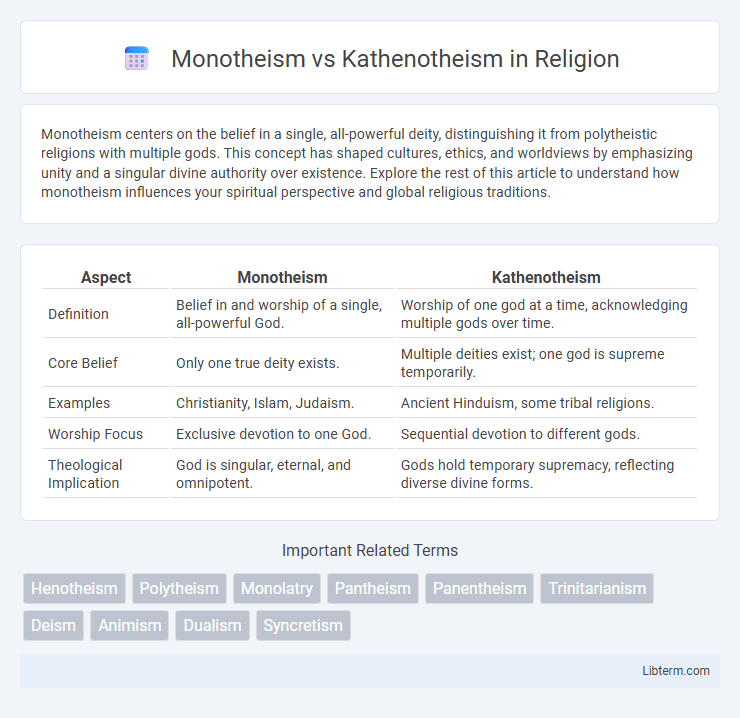Monotheism centers on the belief in a single, all-powerful deity, distinguishing it from polytheistic religions with multiple gods. This concept has shaped cultures, ethics, and worldviews by emphasizing unity and a singular divine authority over existence. Explore the rest of this article to understand how monotheism influences your spiritual perspective and global religious traditions.
Table of Comparison
| Aspect | Monotheism | Kathenotheism |
|---|---|---|
| Definition | Belief in and worship of a single, all-powerful God. | Worship of one god at a time, acknowledging multiple gods over time. |
| Core Belief | Only one true deity exists. | Multiple deities exist; one god is supreme temporarily. |
| Examples | Christianity, Islam, Judaism. | Ancient Hinduism, some tribal religions. |
| Worship Focus | Exclusive devotion to one God. | Sequential devotion to different gods. |
| Theological Implication | God is singular, eternal, and omnipotent. | Gods hold temporary supremacy, reflecting diverse divine forms. |
Defining Monotheism: Belief in One Supreme Deity
Monotheism centers on the belief in one supreme deity who embodies ultimate authority and divinity, distinguishing it from other religious frameworks. This singular god concept emphasizes exclusive worship and often asserts the deity's omnipotence, omniscience, and omnipresence. In contrast, kathenotheism acknowledges multiple gods but venerates one deity at a time as supreme, highlighting a dynamic and situational approach to divinity.
Understanding Kathenotheism: Worship of One God at a Time
Kathenotheism involves worshiping one deity at a time while acknowledging the existence of multiple gods, differentiating it from strict monotheism, which recognizes only a single, all-encompassing God. This practice is seen in various ancient religions, such as certain Hindu traditions where devotees focus on a specific god during rituals without denying others. Understanding kathenotheism requires examining its emphasis on episodic devotion, allowing followers to experience intimacy with different divine aspects sequentially rather than simultaneously.
Historical Roots of Monotheism
Monotheism, rooted in ancient Near Eastern traditions, emerged prominently with the Hebrew Israelites around the 1st millennium BCE, emphasizing the worship of a single, all-powerful deity, Yahweh. Kathenotheism, found in early Vedic religion, involves reverence for one god at a time while acknowledging the existence of others, reflecting a transitional phase between polytheism and monotheism. The historical evolution of monotheism is marked by theological consolidation and the rejection of polytheistic frameworks in favor of exclusive divine sovereignty.
Origins and Development of Kathenotheism
Kathenotheism originated in the ancient Vedic traditions of India, where it developed as a form of worship recognizing one god at a time while accepting the existence of multiple deities. This approach contrasts with monotheism, which centers on the belief in a single, exclusive deity from the outset, as seen in later Abrahamic religions. The development of kathenotheism reflects a transitional stage in religious evolution, blending polytheistic elements with a focus on supreme divine manifestations in succession.
Key Differences Between Monotheism and Kathenotheism
Monotheism centers on the belief in a single, all-encompassing deity, whereas kathenotheism involves worshiping one god at a time while acknowledging the existence of multiple deities. Key differences include monotheism's exclusive devotion to one supreme god, compared to kathenotheism's sequential focus on different gods depending on context or ritual. Monotheism is predominant in religions like Christianity, Islam, and Judaism, while kathenotheism is often found in certain strands of Hinduism and ancient indigenous practices.
Famous Examples: Monotheistic Religions
Monotheism is exemplified by major religions such as Christianity, Islam, and Judaism, each emphasizing the belief in a single, all-powerful deity like God or Allah. These faiths advocate exclusive worship directed toward one supreme being, distinguishing them from kathenotheism, which involves the worship of multiple gods one at a time. The monotheistic framework profoundly shapes ethical teachings, rituals, and theological doctrines in these religions, uniting billions of adherents worldwide under the concept of one divine entity.
Notable Instances: Kathenotheism in Ancient Cultures
Kathenotheism is notably present in ancient Hindu traditions, where the worship of one god at a time occurs without denying the existence of others, as seen in texts like the Rigveda. This differs from monotheism, which asserts the existence of a single, all-powerful deity, exemplified by ancient Judaism and Christianity. The ancient Greek practice of worshipping different gods as supreme in various contexts also reflects a kathenotheistic approach rather than strict monotheism.
Philosophical Implications of Each Belief System
Monotheism posits the existence of a single, supreme deity, fostering a unified metaphysical framework that emphasizes absolute divine authority and moral absolutes. Kathenotheism, by worshiping one god at a time while acknowledging multiple deities, introduces a pluralistic ontology that challenges fixed notions of ultimate reality and encourages a dynamic, context-dependent spirituality. Philosophically, monotheism often leads to rigid ethical systems grounded in a singular divine will, whereas kathenotheism supports a relativistic approach to truth and morality shaped by varying divine attributes.
Influence on Religious Practice and Ritual
Monotheism influences religious practice by centering rituals around worshiping a single, all-powerful deity, fostering unity and exclusivity in faith expressions. In kathenotheism, rituals often involve alternating veneration of different gods as supreme, allowing diverse divine attributes to be celebrated without conflict. This plurality in worship shapes flexible ceremonies that accommodate multiple deities' significance within a single religious framework.
Modern Perspectives: Monotheism vs Kathenotheism
Modern perspectives on monotheism emphasize the belief in a single, all-encompassing deity, central to religions such as Christianity, Islam, and Judaism, highlighting exclusive worship and doctrinal unity. Kathenotheism, by contrast, recognizes the existence of multiple gods but reveres one deity at a time as supreme, reflecting a more flexible and situational approach to divinity found in some Hindu traditions. Contemporary religious studies explore how kathenotheism challenges rigid monotheistic frameworks by accommodating pluralistic worship within an overarching theological context.
Monotheism Infographic

 libterm.com
libterm.com